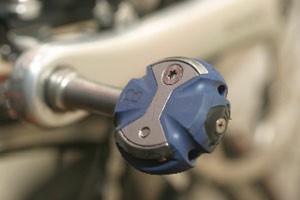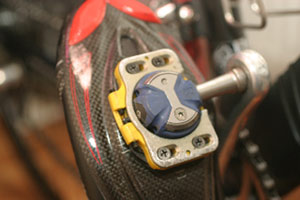Speedplay Zero Stainless Steel pedals £139.99
 |
 |
When autumn comes it’s probably the best time to think about making any of those changes to your set up that have been niggling you while you’ve been riding through those summer months. It had been bugging me since September to test these pedals and see what all the fuss was about.
For those of you who don’t know much about Speedplay I’ll give you a brief history. In 1989 Richard Bryne patented the Speedplay X design. The company itself came to life in 1991 and hase recently just celebrated its 15th year anniversary. The Zero has been in existence now for around 5 years. Bjarne Riis’s CSC team has probably done a lot for the company in recent times, adding both Tour de France stage wins, Paris-Roubaix and a rainbow jersey to the list of triumphs. This year will mark the fourth season the team has been using the pedal system.
Unlike many other systems that owe much of their DNA to the original Look system, Speedplay took a very different route. They basically reversed traditional thinking and placed the retention system in the cleat and not in the pedal. This has quite a few benefits over the normal clipless pedal design. Lower stack height at the shoe interface as the cleat engulfs the pedal results in a more fluid pedal stroke, which is noticeable when climbing. A double-sided nature to the pedal that almost removes missing the pedal engagement. Individual biomechanical set up for each foot.
The Zero pedals are very light; the pedals weigh in at 212g a pair and the cleats including hardware hit the scales at 118g using the short screws. These actual weights are very close to the claimed weights on Speedplay’s website, which is very unusual for most manufacturers. The pedal itself has only one main moving part, which is the axle itself. Another great feature of this pedal is that it is completely rebuildable and all parts are available. The welcome provision of a greaseport, accessible through the removal of the end screw, makes regreasing the bearings a dream.
Initially it seems to takes ages to fit the cleats as you have seven screws to install compared to the normal three. This is one case where reading the manual before starting really comes into play otherwise you could strip a screw. The cleat itself is separated into two main parts, the first being the base plate that allows fore and aft adjustment with only a very small amount of side-to-side adjustment. (Note there is an extender base plate that will allow you to run the cleats further forward, this is popular with Pro riders) The second part of the cleat allows for the side-to-side adjustment, which will enable you to set the pedals in a position that has better relation to your pelvis. Also on this part of the cleat comes the float adjustment. Unlike other pedals you do not have to balance the cleat set up, but you can set both the inward and outward rotation. Because this does not affect the spring tension of the pedal, each foot can be optimised.
The advice I received from Nick at Speedplay on cleat setup worked well as it made plenty of sense. He advised to use the ‘Heel-In’ adjuster so that it didn’t hit the chainstay and to open the ‘Heel-Out’ to the full float. This allows the foot to find its own natural position and not one that is limited by the float of the cleat. If upon use you find that having the float completely open is not to your liking you can of course use the ‘Heel-Out’ screw to reduce the float. The cleats come with shims that allow the base plate to sit flush with the sole of your shoe. I did not need to use them on the shoe I normally ride with, but these should help match the curvature of the soles better, resulting in a secure fit. The cleats themselves will require some lubing from time to time. Speedplay recommend a Teflon based lube. I have been lubing them about once a fortnight, bearing in mind the wet weather we are currently having.
In use the pedal initially feels very different to my previous pedal. I no longer had this ‘locked in’ feeling. At first this felt strange but after the first week I found I actually preferred how this pedal felt. I felt as secure in the Zeros but lacked that trapped feeling. My knees seemed to appreciate the more float that I was now able to offer them. It has not resulted in a loss of cadence on the bike, which for me has equal importance with the float it offers me.
Bearing in mind that I have not altered anything else on my bike I am still amazed by the new levels of comfort I now experience with these pedals. Speedplay have always had a good reputation among knee sufferers, but this really is limiting the real gains of the system. Comfort and performance go hand in hand and I can now see why these pedals are so popular. I think that these pedals answer all the important questions that you can ask of a pedal; good shoe to pedal interface, low stack height, aerodynamic (not many pedals can claim that), lightweight, ergonomic fit and ease of use.
Pedals are a personal item on the bike where one person’s passion is another’s poison. Besides all the technical benefits to this pedal, and there are many, the biggest bonus for me was the increased comfort given over extended efforts. If you are currently unhappy or like myself have been curious to how the pedals feel and perform I would encourage you to try a pair. I think you will come back with happy feet.
Verdict
Does everything that could be asked of a road-specific pedal
 Float, cleat adjustment, weight
Float, cleat adjustment, weight
 Price, time to set up cleat
Price, time to set up cleat








